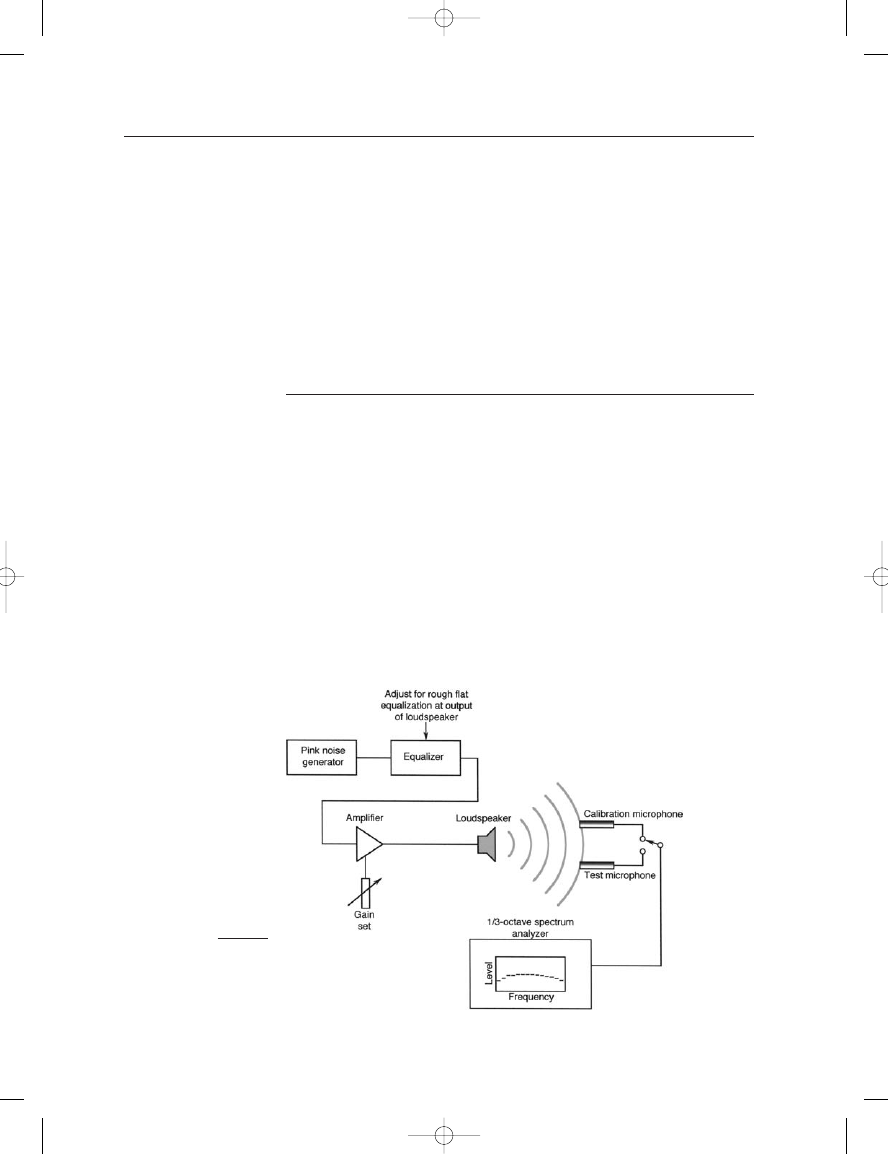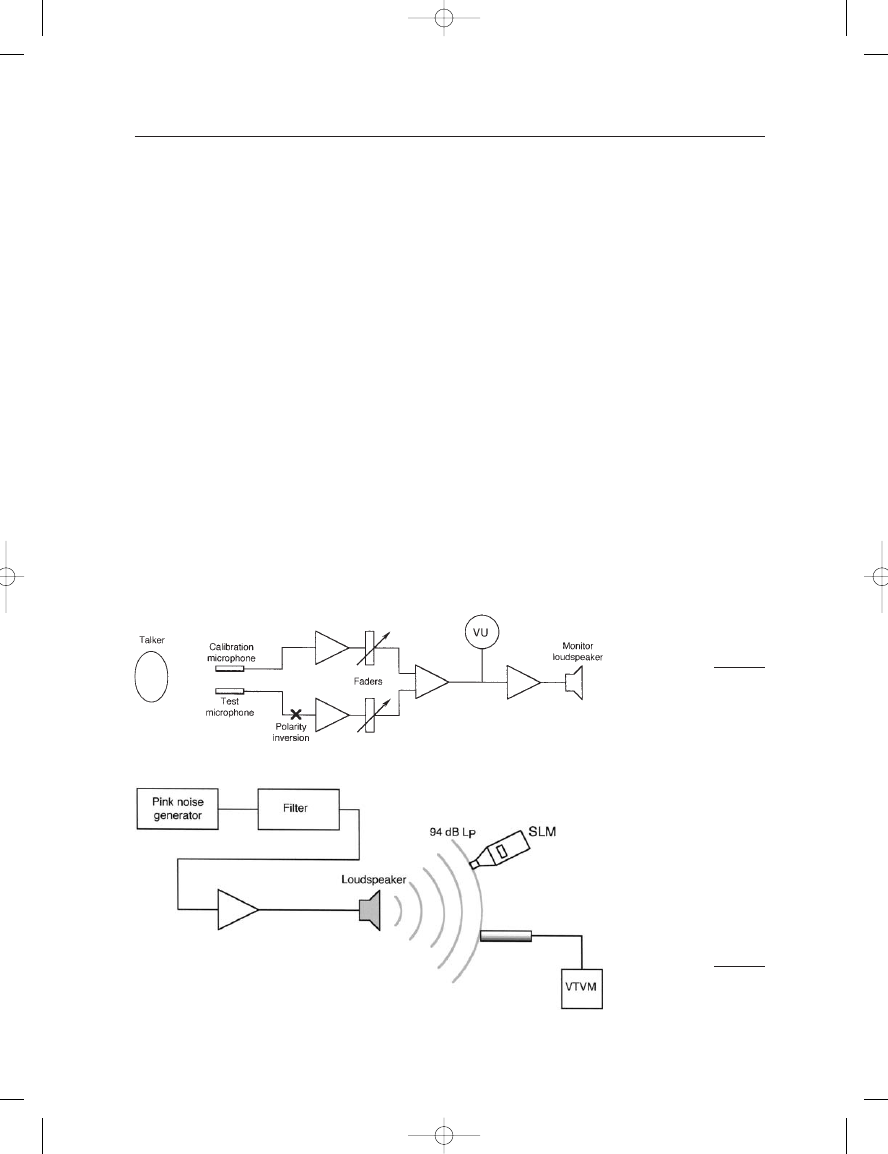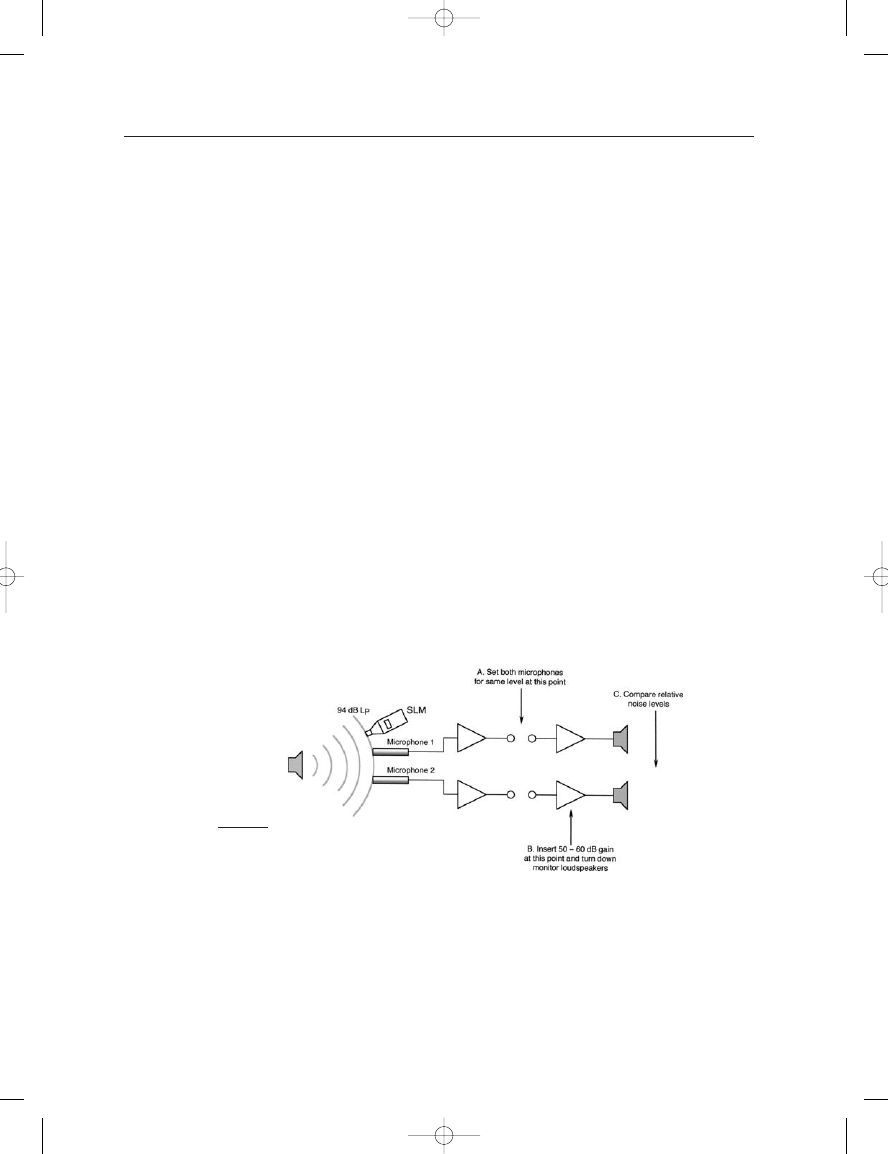ВУЗ: Казахская Национальная Академия Искусств им. Т. Жургенова
Категория: Книга
Дисциплина: Не указана
Добавлен: 03.02.2019
Просмотров: 17248
Скачиваний: 51

The effectiveness of the entire process depends largely on instantaneous
musical balances as they are picked up by the ensemble of all microphones.
If thresholds of the virtual signal are high enough in the main microphone
channels, then the recovery can be excellent. The signal recovered in this
manner can then be used for postproduction rebalancing of the program.
Even in this age of high data rate delivery media, the requirements
of extended multichannel systems will at some point strain the available
hardware resources. The virtual microphone principle offers many
attractive solutions: for example, large venue surround sound presenta-
tions can be outfitted with a large number of ambience channels, each
one corresponding to a microphone positioned in the original recording
venue at various distances, near and far, from the orchestra. If these
signals are recorded via virtual microphones the overall data rate can be
vastly reduced.
FINAL NOTES
In this chapter we have covered only a few of the many areas where
microphone arrays and adaptive signal processing are useful. The inter-
ested reader will want to explore the following application areas:
1. Hearing aids: Taking advantage of binaural hearing, basic beam-
forming techniques can lock in on nearby sources, providing the
hearing-impaired user with stronger localization cues and better
speech intelligibility. Adaptive beam-forming can be used to alter the
directivity patterns at each ear, resulting in similar improvements.
2. High-directivity beamforming: As with loudspeakers, large arrays
of microphones can be designed for high directivity over a fairly
wide frequency range. If the arrays are adaptive they can be used
for tracking individual sources over large angular ranges in difficult
environments.
3. Blind deconvolution: In situations where multiple signals of unknown
source location are presented simultaneously, advanced techniques
can be used, within broad limits, to sort out the signals.
An excellent starting point for further studies is the book
Microphone Arrays (Brandstein and Ward, 2001).
19: Overview of Microphone arrays and Adaptive Systems
333
Earg_19.qxd 14/9/04 3:05 PM Page 333

C
H
A
P
T
E
R
2
0
CARE AND MAINTENANCE
OF MICROPHONES
INTRODUCTION
There is relatively little that sound engineers and technicians can do in
the way of actual maintenance of microphones, outside of minor exter-
nal repairs. Far more important are the routine things that can be done
on a daily basis to care for them and to ensure that they are working
properly. All technical personnel in a given broadcast, recording, or
sound reinforcement activity should be taught the rudiments of proper
microphone handling, and if these rules are followed a microphone
should last virtually indefinitely with little or no departure from its
original response. In addition, there are number of easy measurements
and performance comparisons that may determine if a microphone is
performing according to its specifications.
GENERAL RECOMMENDATIONS
When not in actual studio use, microphones should be stored in the
boxes in which they were shipped. A good alternative here is to construct
a cabinet with felt-lined sections for each microphone, and it is recom-
mended that the microphone clip, or mount, normally used with the
model be stored in the same slot. Fussy managers will demand that the
cabinet be locked at all times and that operating personnel be given keys.
Many older models of dynamic and ribbon microphones have open mag-
netic structures with a considerable stray magnetic field that can attract
ferric dust particles. Over the years this dust can pile up and possibly
impair performance, so be on the lookout for it.
Handheld microphones take the greatest abuse in any location.
Inexperienced users may inadvertently drop them, and prolonged close-in
use will result in breath moisture, even saliva, on the protective screen. It
is a good idea to wipe off all handheld microphones after use with a
Earg_20.qxd 14/9/04 3:05 PM Page 334

moistened lint-free cloth. Studio quality capacitor microphones are
normally stand-mounted and protected with a pop screen or slip-on foam
screen. Keep enough of these devices on hand for backup replacement.
Modern dynamic microphones are surprisingly rugged and can
sustain multiple drops. Much the same can be said for small format
capacitor models, but large format capacitors will usually end up with
dented screens if dropped. In most variable pattern models, the dual
diaphragm element is suspended on a small post. Some of the vintage
models have been known to break at this point when dropped, so
proceed with caution.
PERFORMANCE CHECKS
If there is any question about the frequency response of a microphone, it
can be checked one of two ways. Figure 20–1 shows a method for com-
paring a questionable microphone with one known to be in excellent
operating condition. First, use the reference microphone to arrive at a
rough equalization for flat response as shown on the RTA. (This will
facilitate seeing any clear differences between the response of the two
microphones.) Then, using the same microphone location, substitute the
questionable microphone and compare the two. A test such as this is not
as rigorous as would be carried out in the manufacturer’s laboratory, but
it will enable you to identify a problem. You should also be aware that
not all microphones of a given model are identical in frequency response.
The published specifications will usually make this clear.
The test should be done in a fairly dead acoustical space and as iso-
lated as possible from early reflections. Do not be overly concerned that
20: Care and Maintenance of Microphones
335
FIGURE 20–1
Comparing frequency
response of two
microphones using a
real-time analyzer.
Earg_20.qxd 14/9/04 3:05 PM Page 335

neither of the two response curves will look flat. What you are looking
at here is a combination of both loudspeaker and microphone response,
and your concern should be only with the differences between the two
microphone curves.
An alternate method is shown in Figure 20–2. In this test the two
microphones are placed as close together as possible, and a talker is
placed about 1 m (40 in) away. Feed both microphones into a console
and set both trims and faders to the same positions. Then, invert the
polarity of one of the microphones. If the microphones are well matched
the sound level produced by the control room monitors will drop con-
siderably. You may need to make a fine adjustment to one of the trim
controls in order to null out the response to the maximum degree. This
test is not quite as rigorous at the first, but it will isolate any serious dif-
ferences between the microphones.
You can get a rough idea of relative microphone sensitivities using the
test setup shown in Figure 20–3. The test should be carried out in a studio
and well away from any reflective boundaries. You will need a sound level
meter (SLM) to set the level 1 m from the small loudspeaker to approxi-
mately 94 dB L
P
as measured on the C or flat scale. In the laboratory a
precision SLM would be used for this purpose, but our concern here is
primarily with the relative sensitivities between pairs of microphones.
Both microphone and SLM should be located 1 m from the loud-
speaker, and for most purposes the measurement should be made using
THE MICROPHONE BOOK
336
FIGURE 20–2
Comparing frequency
response of two
microphones by nulling
their outputs.
FIGURE 20–3
Comparing microphone
sensitivity.
Earg_20.qxd 14/9/04 3:06 PM Page 336

an octave-wide band of pink noise centered at 1 kHz. Rough sensitivity
comparisons may be read directly from the meter settings on the console
that are necessary to match their levels.
The relative self-noise levels of microphones may be compared by
using an extension of the test we have just discussed. Adjust the two
microphones so that their outputs, as measured in the control room and
using a noise signal of 94 dB L
P
, are equal. Now, without making any
changes in the gain structure, turn off the noise source and move the
microphones to a very distant and quiet location far away from the con-
trol room. A good place might be an isolation room or closet at the far
end of the studio. The intent here is to prevent any audible acoustical
feedback as you proceed with the rest of this test.
Progressively raise the gain of both microphones equally. Do this by
rerouting each microphone through a second set of console inputs so
that you will have enough reserve gain to raise the noise level to a point
where you can clearly hear it. You will progressively have to lower the
control room monitor loudspeakers as you do this, and it is also a good
idea to roll off excess LF response of both microphones via the in-line
equalizers. The key point here is to maintain exactly the same gain in
both microphone channels. Be very careful! With all of this excess gain
you could, with just a little carelessness, damage your monitor loud-
speakers. You may need 50 to 60 dB of added gain in order to hear the
self-noise levels clearly.
When carefully carried out this test will let you make subjective com-
parisons of the noise floors of a pair of microphones. The procedure is
outlined in Figure 20–4.
20: Care and Maintenance of Microphones
337
FIGURE 20–4
Comparing microphone
self-noise floors.
Earg_20.qxd 14/9/04 3:06 PM Page 337